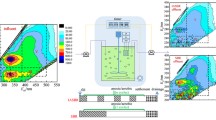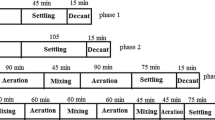Abstract
The effect of aeration rate on nutrient removal from slaughterhouse wastewater was examined in two 10-L laboratory-scale sequencing batch reactors (SBRs—SBR1 and SBR2) operated at ambient temperature. The contaminants in the slaughterhouse wastewater had average concentrations of 4,000 mg chemical oxygen demand (COD) L−1, 350 mg total nitrogen (TN) L−1 and 26 mg total phosphorus (TP) L−1. The duration of a complete SBR operation cycle was 8 h and comprised four operational phases: fill (7 min), react (393 min), settle (30 min) and draw/idle (50 min). During the react phase, the reactors were intermittently aerated four times at 50-min intervals, 50 min each time. DO, pH and oxidation–reduction potential (ORP) in the reactors were real-time monitored. Four aeration rates—0.2 L air min−1 in SBR1 for 70 days, 0.4 L air min−1 in SBR1 for 50 days, 0.8 L air min−1 in SBR2 for 120 days and 1.2 L air min−1 in SBR1 for 110 days—were tested. When the aeration rate was 0.2 L air min−1, the SBR was continuously anaerobic. When the aeration rate was 0.4 L air min−1, COD and TP removals were 90% but TN removal was only 34%. When the aeration rates were 0.8 and 1.2 L air min−1, average effluent concentrations were 115 mg COD L−1, 19 mg TN L−1 and 0.7 mg TP L−1, giving COD, TN and TP removals of 97%, 95% and 97%, respectively. It was found that partial nitrification followed by denitrification occurred in the intermittently aerated SBR systems.









Similar content being viewed by others
References
APHA (1995). Standard methods for the examination of water and wastewater. Washington: APHA.
Casellas, M., Dagot, C., & Baudu, M. (2006). Set up and assessment of a control strategy in a SBR in order to enhance nitrogen and phosphorus removal. Process Biochemistry, 41, 1994–2001.
Cassidy, D. P., & Belia, E. (2005). Nitrogen and phosphorus removal from an abattoir wastewater in a SBR with aerobic granular sludge. Water Research, 39, 4817–4823.
Chuang, H. P., Ohashi, A., Imachi, H., Tandukar, M., & Harada, H. (2007). Effective partial nitrification to nitrite by down-flow hanging sponge reactor under limited oxygen condition. Water Research, 41, 295–302.
Ciudad, G., Rubilar, O., Munoz, P., Ruiz, G., Chamy, R., Vergara, C., & Jeison, D. (2005). Partial nitrification of high ammonia concentration wastewater as a part of a shortcut biological nitrogen removal process. Process Biochemistry, 40, 1715–1719.
Del Pozo, R., & Diez, V. (2005). Integrated anaerobic–aerobic fixed-film reactor for slaughterhouse wastewater treatment. Water Research, 39, 1114–1122.
European Commission (2005). Integrated pollution prevention and control: reference document on best available techniques in the slaughterhouses and animal by-products industries. Brussels: European Commission.
Filali-Meknassi, Y., Auriol, M., Tyagi, R. D., Comeau, Y., & Surampalli, R. Y. (2005). Phosphorus co-precipitation in the biological treatment of slaughterhouse wastewater in a sequencing batch reactor. Practice Periodical of Hazardous, Toxic, and Radioactive Waste Management, 9, 179–192.
Fuchs, W., Binder, H., Mavrias, G., & Braun, R. (2003). Anaerobic treatment of wastewater with high organic content using a stirred tank reactor coupled with a membrane filtration unit. Water Research, 37, 902–908.
Howlett, B., Bolton, D. J., & O’Sullivan, C. (2005). Development of pre-requisite programmes and HACCP principles for Irish beef slaughterhouses. Wexford: Teagasc.
Irish EPA (2006). Draft BAT guidance note on best available techniques for the slaughtering sector. Wexford: Irish EPA.
Johns, M. R., Harrison, M. L., Hutchinson, P. H., & Beswick, P. (1995). Sources of nutrients in wastewater from integrated cattle slaughterhouses. Water Science and Technology, 32(12), 53–58.
Kim, H., & Hao, O. J. (2001). pH and oxidation–reduction potential control strategy for optimization of nitrogen removal in an alternating aerobic–anoxic system. Water Environment Research, 73, 95–102.
Kuba, T., van Loosdrecht, M. C. M., Brandse, F. A., & Heijnen, J. J. (1997). Occurrence of denitrifying phosphorus removing bacteria in modified UCT-type wastewater treatment plants. Water Research, 31, 777–786.
Lee, D. S., Jeon, C. O., & Park, J. M. (2001). Biological nitrogen removal with enhanced phosphate uptake in a sequencing batch reactor using single sludge system. Water Research, 35, 3968–3976.
Lee, Y., & Oleszkiewicz, J. A. (2003). Effects of predation and ORP condition on the performance of nitrifiers in activated sludge systems. Water Research, 37, 4202–4210.
Li, J. P., Healy, M. G., Zhan, X., & Rodgers, M. (2008). Nutrient removal from slaughterhouse wastewater in an intermittently aerated sequencing batch reactor. Bioresource Technology, DOI 10.1016/j.biortech.2008.02.001.
Marsili-Libelli, S. (2006). Control of SBR switching by fuzzy pattern recognition. Water Research, 40, 1095–1107.
Meinhold, J., Arnold, E., & Isaacs, S. (1999). Effect of nitrite on anoxic phosphate uptake in biological phosphorus removal activated sludge. Water Research, 33, 1871–1883.
Merzouki, M., Bernet, N., Delgenes, J. P., & Benlemlih, M. (2005). Effect of prefermentation on denitrifying phosphorus removal in slaughterhouse wastewater. Bioresource Technology, 96, 1317–1322.
Mittal, G. S. (2006). Treatment of wastewater from abattoirs before land application—a review. Bioresource Technology, 97, 1119–1135.
Mota, C., Head, M. A., Ridenoure, J. A., Cheng, J. J., & de los Reyes, F. L. (2005a). Effects of aeration cycles on nitrifying bacterial populations and nitrogen removal in intermittently aerated reactors. Applied and Environmental Microbiology, 71, 8565–8572.
Mota, C., Ridenoure, J., Cheng, J. Y., & de los Reyes, F. L. (2005b). High levels of nitrifying bacteria in intermittently aerated reactors treating high ammonia wastewater. FEMS Microbiology and Ecology, 54, 391–400.
Nazik, A., & Derin, O. (2005). Mechanism and design of sequencing batch reactors for nutrient removal. London: IWA.
Oyanedel-Craver, V., Ruiz, G., & Chamy, R. (2005). Nitrite accumulation in activated sludge and airlift reactors: process performance comparison. Environmental Engineering Science, 22, 450–458.
Ra, C. S., Lo, K. V., Shin, J. S., Oh, J. S., & Hong, B. J. (2000). Biological nutrient removal with an internal organic carbon source in piggery wastewater treatment. Water Research, 34, 965–973.
Ruiz, G., Jeison, D., & Chamy, R. (2003). Nitrification with high nitrite accumulation for the treatment of wastewater with high ammonia concentration. Water Research, 37, 1371–1377.
Shimabukuro, M., Yang, P.-Y., & Kim, S.-J. (2004). Applicability of oxidation reduction potential response on a full-scale intermittently aerated suspended culture system. Practice Periodical of Hazardous, Toxic and Radioactive Waste Management, 8, 19–25.
Tilche, A., Bacilieri, E., Bortone, G., Malaspina, F., Piccinini, S., & Stante, L. (1999). Biological phosphorus and nitrogen removal in a full scale sequencing batch reactors treating piggery wastewater. Water Science and Technology, 40(1), 199–206.
Acknowledgements
This project is funded by the Irish EPA under the ERTDI programme (Project Reference Number: 2005-ET-MS-31-M3). The authors wish to thank Dr. Brian Donlon, EPA, and Mr. Brain Cloonan and Ms. Caroline Scanlan, Western Proteins, Co. Mayo, for their help and support.
Author information
Authors and Affiliations
Corresponding author
Rights and permissions
About this article
Cite this article
Li, J., Healy, M.G., Zhan, X. et al. Effect of Aeration Rate on Nutrient Removal from Slaughterhouse Wastewater in Intermittently Aerated Sequencing Batch Reactors. Water Air Soil Pollut 192, 251–261 (2008). https://doi.org/10.1007/s11270-008-9652-9
Received:
Accepted:
Published:
Issue Date:
DOI: https://doi.org/10.1007/s11270-008-9652-9




